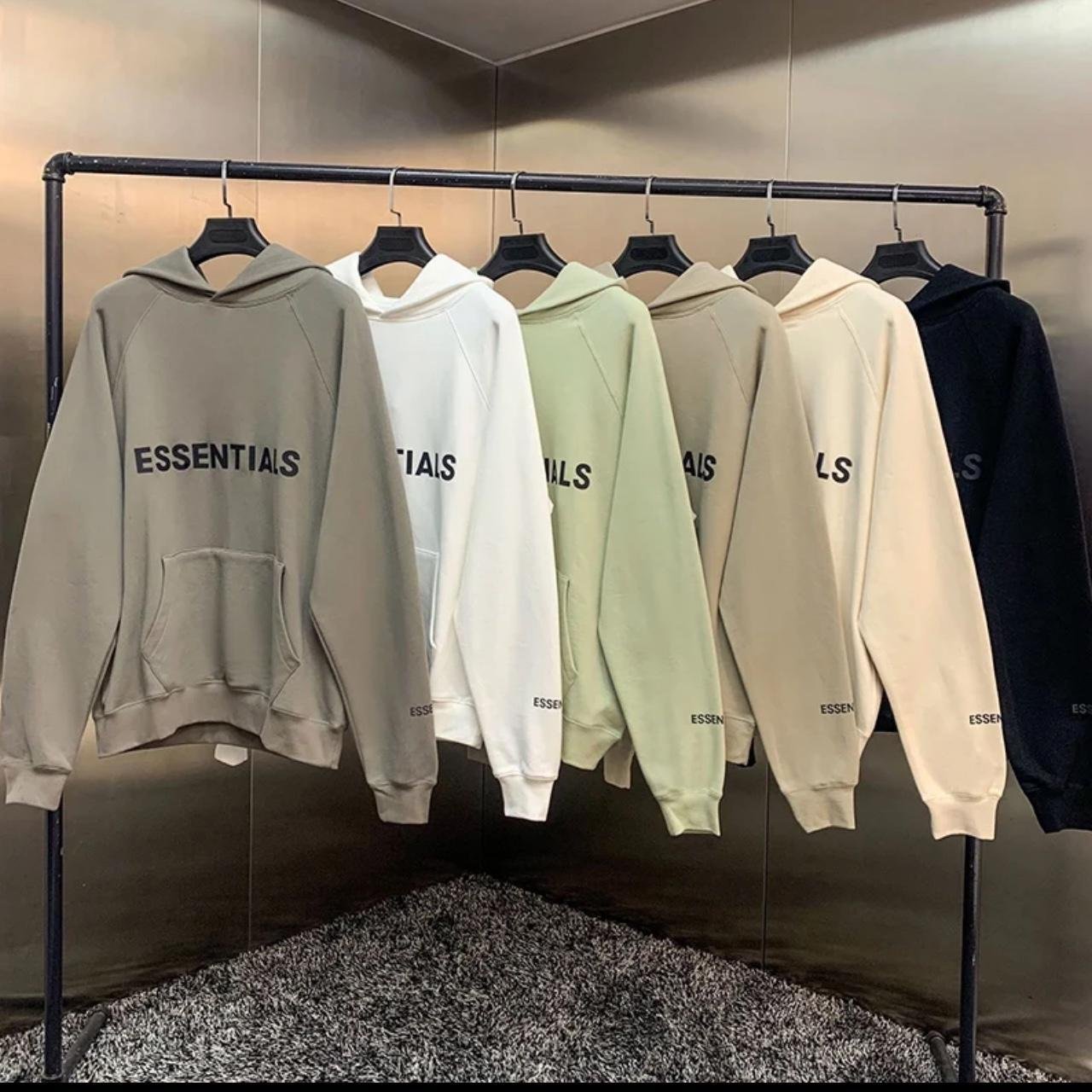The “essential hoodie,” now often paired with the added attributes of “organic cotton,” has emerged as a potent symbol. It represents comfort, casual style, and, increasingly, a conscious consumer choice. However, the path to a truly sustainable and ethically produced hoodie, and by extension, a fully sustainable fashion industry, is not without its hurdles. While the benefits of organic cotton and responsible manufacturing are clear, several significant challenges Essential Hoodie remain, demanding innovative solutions and collaborative efforts. This essay will delve into these obstacles, examining the complexities surrounding the production, distribution, and consumption of the essential hoodie, ultimately painting a picture of the future trajectory of sustainable fashion.
1. The Price Premium: Accessibility and Affordability
One of the most significant barriers to widespread adoption of sustainable practices is the price premium associated with organic cotton and ethical production. While the benefits – reduced environmental impact, improved worker welfare, and often, higher quality – are undeniable, the increased costs can make organic cotton essentials hoodies less accessible, especially for budget-conscious consumers. This creates a disparity, where sustainable choices are often perceived as luxuries, limiting their reach and impact.
- Factors Contributing to Higher Prices:
- Production Costs: Organic cotton farming typically involves higher labor costs, due to the manual weed removal and other practices required to avoid synthetic inputs. Furthermore, the yield per acre may be lower than in conventional farming, leading to higher costs per unit of raw material.
- Certification and Standards: Obtaining organic certifications (e.g., GOTS) requires adherence to rigorous standards, involving audits and documentation that add to the overhead.
- Supply Chain Complexity: Ethical sourcing and transparency often involve tracing the supply chain back to the farm level, which can be more complex and costly than dealing with large-scale conventional suppliers.
- Smaller Scale of Production: The organic cotton market is still smaller than the conventional cotton market, which can result in a lack of economies of scale and higher per-unit costs.
- Addressing the Price Barrier:
- Scaling Up Organic Cotton Production: Increased investment in organic cotton farming and infrastructure could lead to increased supply and lower costs. Governments can provide incentives to farmers to convert to organic practices, and research into improved farming techniques can help boost yields.
- Streamlining Supply Chains: Optimizing supply chains, reducing transportation costs, and building relationships with ethical suppliers can help to drive down prices.
- Consumer Education: Educating consumers about the value of sustainable products can influence their purchasing decisions, making them more willing to pay a premium for quality, ethical production, and environmental responsibility.
- Innovation in Materials and Processes: Research and development into alternative sustainable materials, such as recycled fibers, innovative dyeing techniques, and other eco-friendly processes, can offer cost-effective alternatives to organic cotton.
- Government Incentives and Policy: Governments can play a vital role by implementing policies that support sustainable fashion, such as tax breaks for companies using organic cotton, import duties that favor sustainably produced items, and subsidies to encourage the purchase of ethical clothing.
2. Supply Chain Transparency and Traceability: Navigating Complexity
Ensuring transparency and traceability throughout the supply chain of an essential hoodie, or any garment, is a complex undertaking. The fashion industry is globalized, with intricate supply chains that can involve multiple layers of suppliers, manufacturers, and subcontractors, often spanning across continents. This complexity can make it difficult to monitor labor practices, environmental impact, and the origins of materials.
- Challenges to Transparency:
- Lack of Visibility: Many brands have limited visibility into their supply chains, making it difficult to ensure ethical and environmental compliance at every stage.
- Subcontracting and Hidden Factories: Some factories use subcontractors or operate “hidden” factories, making it difficult to track and monitor production.
- Data Collection and Management: Collecting and managing data about the supply chain can be a time-consuming and resource-intensive process.
- Confidentiality Concerns: Suppliers may be reluctant to share sensitive information about their operations.
- Solutions for Enhancing Transparency:
- Blockchain Technology: Implementing blockchain technology can provide a secure and transparent record of the supply chain, tracking materials from origin to finished product.
- Digital Mapping and Tracking: Utilizing digital platforms to map and track supply chains, providing real-time information about production, location, and worker conditions.
- Third-Party Audits and Verification: Conducting independent audits and certifications to verify compliance with ethical and environmental standards.
- Building Strong Relationships with Suppliers: Fostering long-term relationships with suppliers, based on trust and collaboration, to encourage transparency and accountability.
- Standardized Data Collection and Reporting: Adopting standardized data collection and reporting systems to facilitate the sharing of information throughout the supply chain.
3. Greenwashing and Misleading Marketing: The Risk of Deception
The growing demand for sustainable products has led to an increase in greenwashing, where brands make misleading or unsubstantiated claims about their environmental or social performance. This can undermine consumer trust and hinder the progress of genuine sustainable initiatives.
- Examples of Greenwashing:
- Vague Claims: Using vague terms like “eco-friendly” or “sustainable” without providing concrete details about specific practices or certifications.
- Selective Disclosure: Highlighting certain aspects of sustainability while ignoring other areas where the company’s performance is poor.
- False Labels and Certifications: Displaying fake or misleading certifications to create the impression of sustainability.
- Focus on Packaging over Production: Emphasizing eco-friendly packaging while ignoring the environmental impact of the product itself.
- Combating Greenwashing:
- Consumer Education and Awareness: Educating consumers about greenwashing tactics and encouraging them to look for credible certifications and verifiable information.
- Stricter Regulation and Enforcement: Implementing stricter regulations and enforcing them to prevent companies from making misleading claims.
- Third-Party Verification and Certification: Relying on independent third-party certifications to verify sustainability claims.
- Transparency and Openness: Encouraging brands to be transparent about their practices, disclosing detailed information about their supply chains, materials, and environmental impact.
- Holding Brands Accountable: Consumers can play a crucial role by holding brands accountable for their claims, demanding evidence to support sustainability claims and reporting instances of greenwashing.
4. Consumer Behavior and Consumption Patterns: Shifting Mindsets
Ultimately, the success of sustainable fashion depends on a shift in consumer behavior and consumption patterns. While interest in ethical and sustainable products is growing, many consumers still prioritize price, style, and convenience over sustainability.
- Challenges Related to Consumer Behavior:
- Overconsumption: The fast fashion model promotes frequent purchases, leading to overconsumption and increased textile waste.
- Lack of Awareness: Some consumers may not be fully aware of the social and environmental impact of their clothing choices.
- Price Sensitivity: Price can be a major factor in purchasing decisions, even for consumers who are interested in sustainability.
- Inertia and Habit: Consumers may be resistant to changing their shopping habits or trying new brands.
- Strategies for Influencing Consumer Behavior:
- Education and Awareness Campaigns: Launching education campaigns to inform consumers about the social and environmental impact of their clothing choices.
- Promoting Slow Fashion and Conscious Consumption: Encouraging consumers to buy less, choose durable and timeless garments, and prioritize quality over quantity.
- Making Sustainable Choices More Convenient: Making sustainable clothing more accessible and affordable, through online marketplaces, rental services, and other innovative models.
- Creating Positive Associations with Sustainable Brands: Developing strong brand stories and marketing campaigns that highlight the benefits of sustainable products.
- Empowering Consumers: Providing consumers with the tools and information they need to make informed purchasing decisions, such as labeling systems, product ratings, and access to supply chain information.
- Encouraging Repair and Upcycling: Promoting the repair, alteration, and upcycling of clothing to extend its lifespan and reduce waste.
- Community and Collaboration: Fostering a sense of community and collaboration around sustainable fashion, through events, workshops, and online platforms.
5. The Future of Sustainable Fashion: A Transformative Vision
The challenges facing the essential hoodie and the broader sustainable fashion movement are significant, but the future remains promising. With continued innovation, collaboration, and a shift in consumer mindset, the fashion industry can transform into a more sustainable, ethical, and equitable system.
- Key Trends Shaping the Future:
- Circular Economy Models: Embracing circular economy models, such as clothing rental, resale, and recycling, to reduce waste and extend the life of garments.
- Sustainable Materials and Innovation: Investing in research and development of new sustainable materials, such as bio-based fabrics, recycled textiles, and innovative dyeing techniques.
- Transparency and Traceability: Enhancing transparency and traceability throughout the supply chain, using technologies like blockchain to track materials and production.
- Ethical Production and Worker Empowerment: Prioritizing ethical labor practices and worker well-being, ensuring fair wages, safe working conditions, and worker empowerment.
- Consumer Engagement and Education: Actively engaging and educating consumers about the social and environmental impact of their clothing choices, and empowering them to make more informed purchasing decisions.
- Data-Driven Decision Making: Using data to inform decision-making and track progress, focusing on key metrics such as carbon emissions, water usage, and worker welfare.
- Collaboration and Partnership: Fostering collaboration and partnership among brands, suppliers, governments, NGOs, and consumers to achieve shared sustainability goals.
The organic cotton essentials hoodie, and the broader movement towards sustainable fashion, is not merely a trend; it is a fundamental Essentials Sweatpants shift towards a more responsible and equitable industry. By addressing the challenges and embracing innovative solutions, the fashion industry can create a future where clothing production benefits both people and the planet. The ultimate goal is not just a sustainable hoodie, but a sustainable fashion system that values people, planet, and profit in equal measure.




